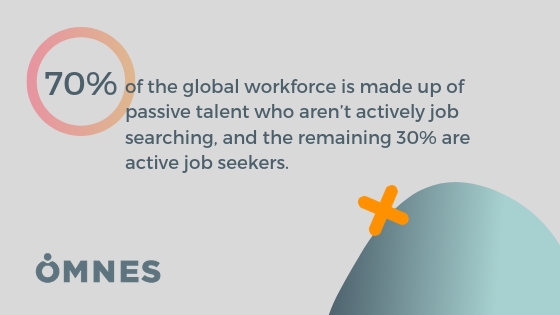IT Recruiting
What is Social Media Recruiting?

Social media is used worldwide today since pretty much everybody has access to it. The modern talent landscape has fundamentally shifted. With 91% of recruiters now using social media in their hiring process and 84% of organizations actively recruiting through these platforms, we’re witnessing a complete transformation in how technical talent is discovered and engaged.
Social media recruiting leverages digital platforms to identify, attract, and engage potential candidates—both active job seekers and passive talent who aren’t actively looking but possess the skills your growing tech team needs. What makes this approach particularly powerful in today’s market is its ability to reach the 82% of passive candidates who, according to recent data, represent the highest-quality hires in competitive technical roles.
The current reality? Traditional job boards are losing effectiveness for specialized technical positions. Senior developers, DevOps engineers, and cybersecurity professionals increasingly expect hiring teams to meet them where they already spend their time, across professional networks, industry communities, and platforms where they consume technical content.
Why is social media recruiting important and what are the benefits of using social media for recruiting?
The shift toward social platforms isn’t just about reach—it’s about accessing talent pools that traditional methods miss entirely. With 79% of job seekers now using social media to find opportunities, and the global talent shortage intensifying in specialized roles, your recruiting strategy needs to adapt to where candidates actually are.
Here’s what’s driving the transformation:
Skills-Based Discovery: Modern platforms enable you to identify candidates based on actual technical capabilities rather than just keywords on resumes. Skills-based hiring continues to rise, with companies increasingly using platforms to find talent with specific competencies regardless of traditional qualifications.
Access to Passive Talent: More than 85% of employers report that social media helps them find and engage passive job seekers—the experienced engineers, data scientists, and product managers who aren’t actively job hunting but might be open to the right opportunity.
Authentic Employer Branding: Unlike polished career pages, social platforms allow candidates to see genuine workplace culture, team dynamics, and the day-to-day reality of working with your technology stack. This transparency helps reduce turnover by 28% when done effectively.
Cost Efficiency: Social media recruiting shows a 68.2% lower cost-per-click compared to other recruitment marketing methods, making it particularly valuable for scaling technical teams without proportionally scaling recruiting budgets.
The most significant advantage? Quality over volume. Rather than sorting through hundreds of generic applications, social recruiting enables targeted outreach to professionals who match your specific technical requirements and team culture.
Using LinkedIn for Tech Talent Acquisition
LinkedIn remains the cornerstone of professional social recruiting, but the platform has evolved far beyond basic profile searching. Recent AI-assisted features now help recruiters identify qualified candidates 40% faster, with enhanced search capabilities that surface skills and experiences not explicitly listed on profiles.
Advanced Platform Capabilities:
AI-Enhanced Search: Modern LinkedIn Recruiter uses generative AI to analyze job requirements and create dynamic candidate pools, automatically surfacing professionals with relevant skills as they become available. This is particularly effective for niche technical roles where specific framework experience or architectural knowledge is crucial.
Skills Verification: The platform now provides deeper insights into candidates’ actual capabilities, pulling skills data from resumes and project histories to complete profiles. This helps identify React developers who understand hooks, DevOps engineers with container orchestration experience, or data engineers familiar with real-time streaming architectures.
Engagement Intelligence: New features identify candidates showing interest signals—”Open to work” status, company engagement, and InMail acceptance rates—helping prioritize outreach to receptive talent.
Strategic Approach for Technical Hiring:
Build comprehensive company profiles that showcase your technical environment. Highlight specific technologies, development methodologies, and engineering practices that serious technical professionals care about. Share content about architectural decisions, technology adoption, and engineering culture—not just generic company updates.
Leverage automated features for efficiency: 40% higher InMail acceptance rates come from personalized outreach, and AI-assisted messaging can help craft relevant, technical communications that resonate with specialized candidates.
Pro Tip: Connect strategically with current and former technical team members. Their networks often contain the most relevant professionals for similar roles, and employee referrals consistently produce higher-quality hires in technical positions.

Expanding Beyond LinkedIn: Twitter, Instagram, and Emerging Platforms
The technical talent landscape extends well beyond LinkedIn. While 41% of recruiters identify LinkedIn as their primary channel, 20% actively use Facebook, and 10% leverage Twitter for technical recruiting. Understanding where different types of technical professionals engage is crucial for comprehensive talent acquisition.
Twitter/X for Technical Communities:
The platform remains essential for reaching senior engineers, open-source contributors, and technical thought leaders. Use hashtags strategically: #DevOps, #MachineLearning, #WebDev, and specific technology tags (#React, #Kubernetes, #PyTorch) to find professionals discussing industry developments.
Monitor technical conversations rather than just posting job openings. Engage with developers sharing insights about your technology stack, contributing to discussions about architectural patterns, or demonstrating expertise relevant to your open positions.
Instagram for Employer Branding:
76% of Gen Z use Instagram for career content—more than twice as many as LinkedIn (34%). This platform excels at showcasing authentic workplace culture through behind-the-scenes content, team collaboration, and the human side of technical work.
Share high-quality visuals of your development environment, team problem-solving sessions, hackathons, and the innovative projects your engineers work on. Use Instagram Stories to provide day-in-the-life content that helps candidates envision themselves in your technical roles.
Location-Based Features: Instagram and other platforms enable geographic targeting, particularly valuable for finding local talent for hybrid or on-site technical positions.
The TikTok Revolution: Reaching Gen Z Technical Talent
The emergence of TikTok as a career platform represents a fundamental shift: 46% of Gen Z have landed jobs or internships through TikTok, and 92% trust the platform for career advice. For companies hiring junior developers, recent graduates, or early-career technical professionals, ignoring TikTok means missing a significant talent segment.
Why TikTok Matters for Tech Recruiting:
Gen Z, who will account for more than 25% of the workforce by 2025, increasingly prefer TikTok for information discovery, with 74% using it for search and 51% favoring it over Google. This generation of technical talent expects authentic, video-first communication about career opportunities.
Effective TikTok Recruiting Strategies:
Behind-the-Scenes Technical Content: Show real development workflows, code reviews, deployment processes, and problem-solving sessions. Gen Z wants to see the actual work environment, not polished marketing content.
Employee Advocacy: Turn your technical team members into brand advocates who can authentically communicate your employer brand and demonstrate job specifics through their perspectives. A day-in-the-life video from a junior developer or a quick explainer about your testing practices can be more effective than traditional job posts.
Educational Content: 42% of Gen Z comes to TikTok for entertaining content, while 33% prefer learning new things on the platform. Share quick technical tips, industry insights, or explanations of interesting challenges your team has solved.
Authenticity is Non-Negotiable: 48% of Gen Z agree that social media creates unrealistic career expectations, making transparency crucial. Be honest about learning curves, the complexity of technical challenges, and growth opportunities rather than overselling positions.
Building Your Comprehensive Social Media Recruiting Strategy
The evolution of social recruiting requires a strategic, multi-platform approach rather than ad-hoc posting. Modern recruiting teams are empowering entire organizations to participate in talent acquisition, with employee advocacy becoming one of the most effective ways to extend recruiting reach.
Platform-Specific Strategy:
LinkedIn: Professional networking, detailed technical discussions, industry thought leadership, and formal talent acquisition activities.
Twitter/X: Real-time technical conversations, open-source community engagement, and thought leadership in specific technology areas.
Instagram: Authentic workplace culture, visual storytelling, and behind-the-scenes content that showcases your technical environment.
TikTok: Quick, engaging content for early-career talent, day-in-the-life perspectives, and educational technical content.
Content Strategy for Technical Audiences:
Share substantive technical content that demonstrates your team’s expertise: architectural decisions, technology adoption rationales, interesting problem-solving approaches, and lessons learned from complex implementations. Technical professionals evaluate potential employers partly based on the sophistication and innovation evident in their engineering practices.
Employee Activation: Employee-shared content reaches larger, more diverse audiences and feels more authentic than corporate recruiting posts. Encourage your technical team to share their experiences, contribute to industry discussions, and represent your engineering culture naturally.
Measurement and Optimization:
Balance automation with personalization in your recruiting efforts. Use available tools to automate job posting and initial screening while maintaining personal engagement for qualified candidates. Track engagement metrics, application quality, and conversion rates across platforms to optimize your approach.
Quality Over Quantity: Focus on attracting the right candidates rather than maximizing application volume. Modern hiring emphasizes quality over speed, with recruiting professionals prioritizing sourcing high-quality candidates as the number one objective.
Conclusion: The Future of Social Recruiting in Tech
Social media recruiting has evolved from an experimental channel to an essential component of competitive talent acquisition. With 95% of Gen Z considering a company’s social media presence before applying, and passive candidates representing the highest-value segment of the technical talent market, organizations that master social recruiting gain significant competitive advantages.
The key to success lies in understanding that different platforms serve different purposes in the candidate journey. LinkedIn facilitates professional discovery and detailed technical evaluation. Twitter enables community engagement and thought leadership. Instagram showcases authentic culture and workplace reality. TikTok reaches emerging technical talent with authentic, video-first communication.
Rather than viewing social recruiting as separate from your core talent acquisition strategy, integrate it as a comprehensive approach to building relationships with technical professionals throughout their careers—from early-career developers discovering your company through engaging content to senior engineers evaluating your technical leadership through industry contributions.
The most effective social recruiting strategies combine platform-specific tactics with authentic employer branding that accurately represents your technical environment and growth opportunities. In a competitive market where the best technical talent has multiple options, genuine engagement and transparent communication about your engineering culture become key differentiators.
Ready to evolve your technical recruiting strategy? Let’s discuss how current social media trends are reshaping talent acquisition in your specific technical domains and build an approach that connects you with the specialized professionals your team needs to grow.